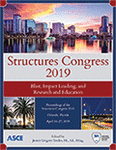Structures Congress 2019
A Scalable Framework for Assessing Seismic Resilience of Communities
Publication: Structures Congress 2019: Blast, Impact Loading, and Research and Education
ABSTRACT
Assessment of the seismic resilience of communities requires modeling the interactions that take place between the multiple systems of society, including engineering, economic, social, financial, environmental, political, and others. The complex interdependencies that arise between these systems is challenging to model because of the multi-disciplinary nature of the problem and range of temporal and spatial scales involved. With this motivation, a fully scalable and adaptable framework is developed for modeling the seismic resilience of communities. The framework includes different simulators, each of which represents various aspects of the problem, such as city layout, regional seismic ground motion, structural response, structural and non-structural damage, and loss assessment. Each simulator is considered as a black box that takes inputs from other simulators and provide outputs in a specific format to be used by other simulators. The proposed framework is demonstrated through a case study that is focused on modeling the resilience of an archetype community facing a seismic hazard.
Get full access to this article
View all available purchase options and get full access to this chapter.
AKNOWLEGMENTS
This work was supported by the University of Michigan, University of Delaware and the US National Science Foundation (NSF) through grant ACI-1638186. Any opinions, findings, conclusions, and recommendations expressed in this paper are those of the authors and do not necessarily reflect the views of the sponsor.
REFRENCES
Almufti, I, Willford, M. (2013) "REDi TM rating system: resilience-based earthquake design initiative for the next generation of buildings." ARUP Co.
Brookshire, D., S. Chang, H. Cochrane, R. Olson, A. Rose, and J. Steenson. (1997). "Direct and indirect economic losses from earthquake damage." Earthquake Spectra 13(4): 683–701.
Bruneau, M., et al. (2003). "A framework to quantitatively assess and enhance the seismic resilience of communities. " Earthquake Spectra, 19(4), 733–752.
Campbell, K. W. and Y. Bozorgnia (2008) "NGA ground motion model for the geometric mean horizontal component of PGA, PGV, PGD and 5% damped linear elastic response spectra for periods ranging from 0.01 to 10s. " Earthquake Spectra, 24(1), 139-171.
Chen, Q.F., Y. Chen, and L. Chen. (1997). "Earthquake loss estimation with GDP and population data." Acta Seimologica Sinica 10(4):791–800.
FEMA. (2012a). "Seismic performance assessment of buildings." FEMA P58-1, Applied Technology Council, Redwood City, CA.
FEMA. (2012b). "Performance Assessment Calculation Tool (PACT)" FEMA P58-3, Applied Technology Council, Redwood City, CA.
FEMA (2006) "Next-generation performance-based seismic design guidelines program plan for new and existing buildings. " Technical report FEMA-445, Washington DC.
FEMA. (2009) "Quantification of building seismic performance factors." Rep. No. FEMA-P695. Washington, DC: FEMA.
FEMA. (2001) Earthquake Loss Estimation Methodology (HAZUS-MH MR5): Technical Manual. Washington, D.C.
Ibarra, L. F., and Krawinkler, H. (2005). "Global collapse of frame structures under seismic excitations," Technical Report 152, The John A. Blume Earthquake Engineering Research Center, Department of Civil Engineering, Stanford University, Stanford, CA.
Idriss, I.M. and Seed, H.B. (1968) "Seismic Response of Horizontal Soil Layers." Journal of the soil and Foundations Division, ASCE, Vol. 94 No. SM4, July, pp. 1001:1031.
Lignos, D. G., and Krawinkler, H. (2012). "Sidesway Collapse of Deteriorating Structural Systems under Seismic Excitations," Technical Report 177, The John A. Blume Earthquake Engineering Research Center, Department of Civil Engineering, Stanford University, Stanford, CA.
Lin, S.Y.; Xu, Lichao; Chuang, W.C.; El-tawil, S.; S. M. J. Spence; Kamat, V.R.; Menassa, C.C.; McCormick, J. (2018) "Modeling Interactions in Community Resilience. " In Proc. Structures Congress 2018, ASCE, Texas.
MATLAB[Computer software]. MathWorks, Natick, MA.
McKenna, F, Fenves, GL, Scott, MH. (2000) "Open system for earthquake engineering simulation." Berkeley (CA): University of California.
NER (2011). "National Earthquake Resilience: Research, Implementation, and Outreach." Washington, National Academies Press.
NIST. (2010) "Evaluation of the FEMA P695 methodology for quantification of building seismic performance factors. " NIST GCR 10-917-8. Gaithersburg, MD: National Institute of Standards and Technology.
Peterson, J, Small, MJ (2012) "Methodology for benefit-cost analysis of seismic codes." Nat Hazards 63:1039–1053.
Renschler, C., Frazier, A., Arendt, L., Cimellaro, G.P., Reinhorn, A., Bruneau, M. (2010). "Developing the ‘PEOPLES’ resilience framework for defining and measuring disaster resilience at the community scale." In Proc., 9th US National and 10th Canadian Conference on Earthquake Engineering Toronto, pp. 25–29.
Shome, N, Jayaram, N, Krawinkler, H, Rahnama, M (2015) "Loss estimation of tall buildings designed for the peer tall building initiative project." Earthq Spectra 31(3):1309–1336.
Yong, C., Q.F. Chen, and L. Chen. (2001). "Vulnerability analysis in earthquake loss estimate." Nat Hazards 23(2–3): 349–364.
Zeng, X.; Lu, X.; Yang, T.Y.; Xu, Z. (2016) "Application of the FEMA-P58 methodology for regional earthquake loss prediction" Nat Hazards 83:177–192.
Information & Authors
Information
Published In
Structures Congress 2019: Blast, Impact Loading, and Research and Education
Pages: 385 - 394
Editor: James Gregory Soules, McDermott International
ISBN (Online): 978-0-7844-8224-7
Copyright
© 2019 American Society of Civil Engineers.
History
Published online: Apr 22, 2019
Published in print: Apr 22, 2019
Authors
Metrics & Citations
Metrics
Citations
Download citation
If you have the appropriate software installed, you can download article citation data to the citation manager of your choice. Simply select your manager software from the list below and click Download.
